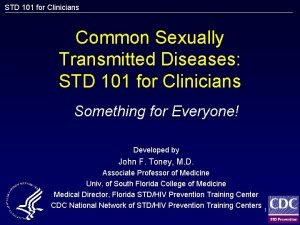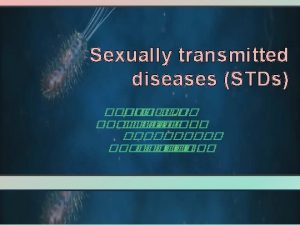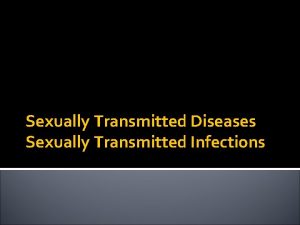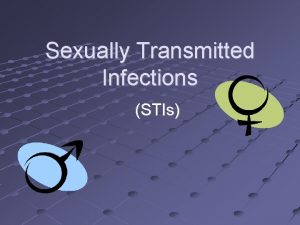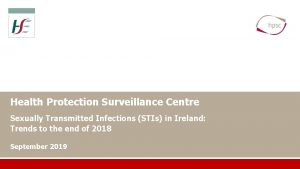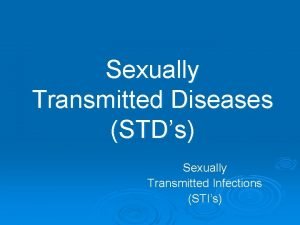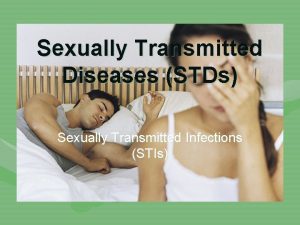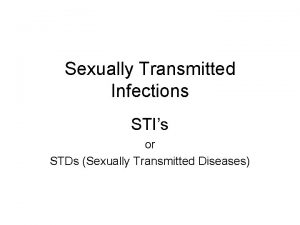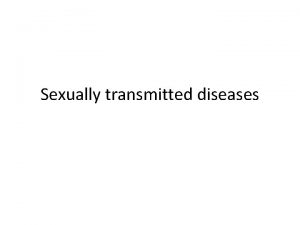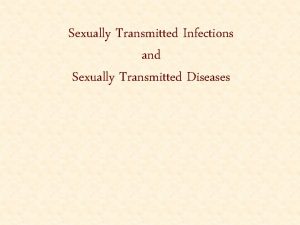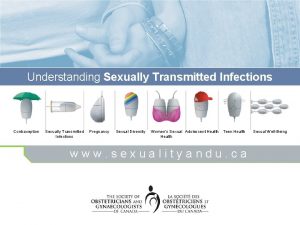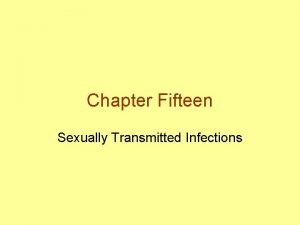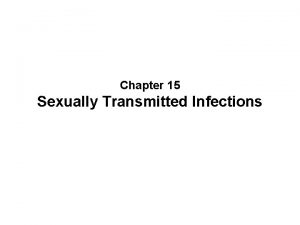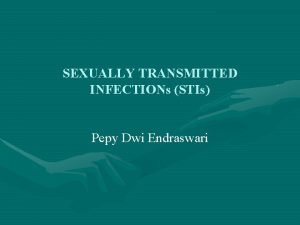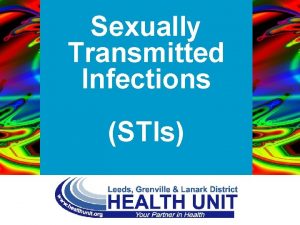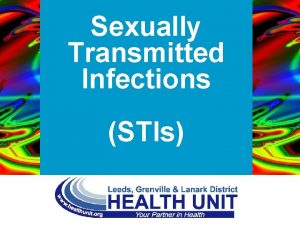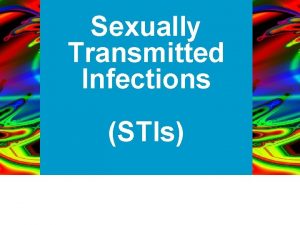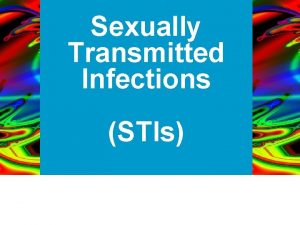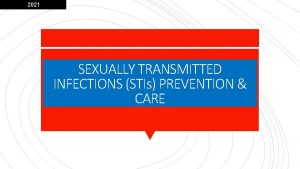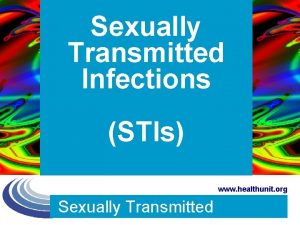Health Protection Surveillance Centre Sexually Transmitted Infections STIs





















- Slides: 21

Health Protection Surveillance Centre Sexually Transmitted Infections (STIs) in Ireland: Latest Trends November 2018

Acknowledgements The Health Protection Surveillance Centre (HPSC) would like to thank all those who provided the data for this report, particularly the STI clinics, infectious disease surveillance staff within the Departments of Public Health, the laboratories and GP clinics. STI data were extracted from CIDR in August, 2018, and may differ from those previously published due to ongoing updating of notification data in CIDR.

STIs in Ireland, 2017 These slides present data on STIs notified to HPSC during 2017 and trends to the end of 2017 More detailed reports on the epidemiology of STIs for 2017 are available on the HPSC website. http: //www. hpsc. ie/CIDR/ http: //www. hpsc. ie/abouthpsc/ annualreports/ www. hpsc. ie HIV, hepatitis B and sexually transmitted enteric infections (STEI), such as shigellosis, are notified via CIDR and are reported separately. 3

Summary of STIs in Ireland, 2017 5% increase compared to 2016 STI N Notification rate / 100, 000 population Ano-genital warts 1, 281 26. 9 25 -29 years Chlamydia 7, 408 155. 4 20 -24 years Gonorrhoea 2, 249 47. 2 20 -24 years Herpes simplex (genital) 1, 554 32. 6 20 -24 years Lymphogranuloma venereum (LGV) 20 0. 4 35 -39 years Non-specific urethritis 652 13. 7 NA* Early infectious syphilis (EIS) 398 8. 4 25 -29 years Trichomoniasis 67 1. 4 20 -24 years Total *Data provided as total numbers only, breakdown by age not available 13, 629 Highest age-specific rate

Burden of disease Who is most affected? • Young people – Rates of chlamydia, herpes simplex and gonorrhoea in 15 -24 year olds increased in 2017; further information on STIs in young people is available at http: //www. hpsc. ie/az/hivstis/sexuallytransmittedinfections/publications/stireports/ – 15 -24 year olds accounted for 51% of chlamydia cases, 38% of herpes simplex cases and 39% of gonorrhoea cases notified in 2017 • MSM (men who have sex with men) – Rates of early infectious syphilis and gonorrhoea in MSM increased in 2017; further information is available in annual epidemiological reports at http: //www. hpsc. ie/abouthpsc/annualreports/ – In 2017, MSM accounted for: • 100% of LGV cases, • 87% of early infectious syphilis cases • 60% of gonorrhoea cases (where mode of transmission was known) 5

Preventing STIs Safer sex § Get tested regularly Further information on free sexual health services is available at – https: //www. sexualwellbeing. ie/ – www. man 2 man. ie (resource for gay, bisexual men) § Use condoms for vaginal, oral and anal sex § Reduce the number of partners and overlapping partners the more partners you have, the greater your chance of coming into contact with an infected person 6

Ano-genital warts in Ireland, 2017 Summary § 1, 281 cases of ano-genital warts were notified in 2017, a 20% decrease compared to 2016 (n=1, 593) § The notification rate continued to decrease to 26. 9 per 100, 000 population in 2017, down from 33. 5 per 100, 000 population in 2016 § 53% of cases were among males § The highest age-specific rate was among 25 -29 year olds, for both males and females, at 97. 1 per 100, 000 population and 48. 6 per 100, 000 population, respectively 7

Ano-genital warts in Ireland Figure 1. Trend in notification rate per 100, 000 population of ano-genital warts, 1995 -2017 8

Chlamydia in Ireland, 2017 Summary § 7, 408 cases of chlamydia were notified in 2017 § Notification rate increased by 8% to 155. 4 per 100, 000 population in 2017 from 144. 2 per 100, 000 in 2016 § Three-quarters of cases were reported in people aged less than 30 years, with the largest proportion aged 20 -24 years (41%) § Just over half of cases were among females with the highest rate among females aged 20 -24 years. The rate in females in this age group is consistently higher than males. In 2017, the rate in females (1, 310. 5 per 100, 000) was almost 1. 5 times greater than in males in this age group (881. 6 per 100, 000) 9

Chlamydia in Ireland Figure 2. Trend in notification rate per 100, 000 population of chlamydia, 1995 -2017 180 Notification rate per 100, 000 population 160 140 120 100 80 60 40 20 0 1995 1996 1997 1998 1999 2000 2001 2002 2003 2004 2005 2006 2007 2008 2009 2010 2011 2012 2013 2014 2015 2016 2017 Year Males Females Total 10

LGV in Ireland, 2017 Summary § 20 cases of Lymphogranuloma venereum (LGV) were notified in 2017 § Notification rate decreased to 0. 4 per 100, 000 population in 2017 from 1. 0 per 100, 000 population in 2016 § 19 cases were among MSM and mode of transmission was missing for one case § Median age: 36 years (range: 20 -65 years) § Where HIV status was known, half of the cases (n=9; 50%) were HIV positive, a reduction in the proportion positive compared to previous years 11

Gonorrhoea in Ireland, 2017 Summary § 2, 249 cases of gonorrhoea were notified in 2017 § Notification rate increased 15% to 47. 2 per 100, 000 population from 41. 0 per 100, 000 population in 2016 § 81% of the notifications were among males (7% increase since 2016) and 19% were among females (71% increase since 2016) § The highest rate of notifications among males was in the 20 -24 year age group (328. 5/100, 000 population) and among females was also the 20‑ 24 year age group (112. 5/100, 000) § Median age: 27 years (range: 15 -79 years) § 60% of cases were among MSM and 40% were among heterosexuals, where mode of transmission was known 12

Gonorrhoea in Ireland Figure 3. Trend in notification rate per 100, 000 population of gonorrhoea, 1995 -2017 Notification rate per 100, 000 population 90 80 70 60 50 40 30 20 10 0 1995 1996 1997 1998 1999 2000 2001 2002 2003 2004 2005 2006 2007 2008 2009 2010 2011 2012 2013 2014 2015 2016 2017 Year Males Females Total 13

Herpes simplex (genital) in Ireland, 2017 Summary § 1, 554 cases of herpes simplex (genital) were notified in 2017 § The notification rate was 32. 6 per 100, 000 population in 2017; a 14% increase since 2016 (28. 7/100, 000) § 71% of cases were among females § The highest age-specific rate was among females aged 20 -24 years (259. 5/100, 000) § Median age: 27 years (range: 14 -85 years) § 56% of cases were laboratory confirmed as herpes simplex virus type 1 and 31% as herpes simplex virus type 2; virus type was unknown for 13% of cases 14

Herpes simplex (genital) in Ireland Figure 4. Trend in notification rate per 100, 000 population of herpes simplex (genital), 1995 -2017 15

Early infectious syphilis in Ireland, 2017 Summary § 398 confirmed cases of early infectious syphilis (EIS) were notified in 2017 § The notification rate increased to 8. 4 per 100, 000 population; up 31% from 2016 (6. 4/100, 000) § 96% of cases were among males § Median age: 34 years (range: 17 -71 years) § The highest age-specific rates in both males and females were among 25 -29 year olds, at 56. 5 per 100, 000 population and 4. 6 per 100, 000 population, respectively § The majority (74%) of cases were reported by HSE East § Where mode of transmission was recorded, 87% of cases were in MSM § Where HIV status was recorded, 38% of EIS cases were co-infected with HIV § Where syphilis reinfection status was recorded, 7% of cases were consistent with syphilis reinfection 16

Early infectious syphilis in Ireland Figure 5. Trend in notification rate per 100, 000 population of early infectious syphilis, 2000 -2017 Case definition updated Case definition and procedure for notification updated 17

Trichomoniasis in Ireland, 2017 Summary § 67 cases of trichomoniasis were notified in 2017, a notification rate of 1. 4 per 100, 000 population § All reported cases were among females with the highest rate among females aged 20 -24 years (8. 8/100, 000 population) § Median age: 32 years (range: 18 -89 years) 18

Trichomoniasis in Ireland Figure 6. Trend in notification rate per 100, 000 population of trichomoniasis, 1995 -2017 19

Other STIs in Ireland, 2017 Summary: chancroid, granuloma inguinale and non-specific urethritis § There were 652 cases of non-specific urethritis (NSU) notified in 2017, a 12% decrease compared to 2016 (n=740). The notification rate continued to decrease, to 13. 7 per 100, 000 population. § There were no notifications of chancroid or granuloma inguinale reported in Ireland in 2017 20

Further Information More detailed tables on these provisional data are available on the HPSC website http: //www. hpsc. ie/az/hivstis/sexuallytransmittedinfections /publications/stireports/ More detailed epidemiological reports are also available on the HPSC website http: //www. hpsc. ie/abouthpsc/annual reports/ You can stay up-to-date with current STI data with the Weekly HIV & STI report http: //www. hpsc. ie/AZ/HIVSTIs/Sexually. Transmitted. Infecti ons/Publications/STIReports/STIWeek ly. Reports/ 21
 Chapter 25 sexually transmitted infections and hiv/aids
Chapter 25 sexually transmitted infections and hiv/aids Chapter 24 lesson 1 sexually transmitted diseases
Chapter 24 lesson 1 sexually transmitted diseases Chapter 24 sexually transmitted diseases and hiv/aids
Chapter 24 sexually transmitted diseases and hiv/aids Std
Std Nursing management of reproductive tract infection
Nursing management of reproductive tract infection Std
Std Opportunistic infections
Opportunistic infections Methotrexate yeast infection
Methotrexate yeast infection Opportunistic infections
Opportunistic infections Understanding the mirai botnet
Understanding the mirai botnet Storch infections
Storch infections Storch infections
Storch infections Bone and joint infections
Bone and joint infections Infections opportunistes digestives
Infections opportunistes digestives Eye infections
Eye infections Postpartum infections
Postpartum infections Retroviruses and opportunistic infections
Retroviruses and opportunistic infections Genital infections
Genital infections Genital infections
Genital infections Ciliary escalator
Ciliary escalator Classification of acute gingival infections
Classification of acute gingival infections Whale phylum
Whale phylum





